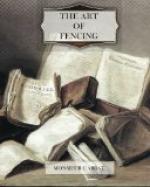The Body must lean a little forward before, to give the Thrust a greater Length; the Hips must not be so much bent as other Times; which weakens and shortens the Thrust, by the Distance which the lowering the Body causes from the Height of the Line which must come from the Shoulder; besides ’tis harder to recover, and you, by that Means, give the Adversary an Opportunity of taking your Feeble with his Fort, your Situation being very low. The Front of the Body should be hid by turning the two Shoulders equally on a Line.
The Foot should go out strait; in order to preserve the Strength and Swiftness of the Thrust, it must have its proper Line and Distance. The Line must be taken from the Inside of the Left Heel to the Point of the Adversary’s Right Foot; If it turn inward or outward, the Button will not go so far, the strait Line being the shortest; besides the Body would be uncovered, for by carrying the Foot inwards, the Flank is exposed, and by carrying it outwards the Front of the Body, and the Body is thereby weakened; the Prop and the Body being obliged to form an Angle instead of a strait Line, from the Heel of the Left Foot to the Point or Button of the Foil.
In order to know the Distance of the Lunge, the Right Knee being bent, must form a perpendicular Line with the Point of the Foot; if the Foot were not so forward, the Heel would be off the Ground, and the Body would have less Strength, and if it were carried farther the Body could not easily bend it self, and consequently could not extend so far; moreover, it would want Strength, being at too great a Distance from the perpendicular Line of the Foot and Leg, which are its Support, and its Recovery would be more difficult.
The Foot should fall firm without lifting it too high, that the Soal of the Sandal, or Pump, may give a smart Sound, which not only looks better and animates more, but also makes the Foot firm, and in a Condition to answer the Swiftness of the Wrist.
Care must be taken not to carry the Point of the Foot inward or outward, because the Knee bending accordingly, as part of the Thigh, goes out of the Line of the Sword, and consequently, of the Line of Defence, besides ’tis very disagreeable to the Sight.
The Feet sometimes slip in the Lunge, the Right Foot sliding forward, or the Left backward; the first is occasioned by carrying out the Foot before the Knee is bent, whereas when the Knee brings it forward, it must fall flat and firm; the other proceeds from the Want of a sufficient Support on the Left Foot.
The Head should follow the Figure of the Body; when this is upright, that should be so to; when the Body leans, the Head must lean; when you push within, you must look at your Adversary on the Outside of your Arm, which is done without turning the Head, by the Opposition of the Hand only.
That every Thrust may carry with it it’s due Extent and Strength, the Opposition of the Sword, the true placing of the Body, and a Facility of recovering; you are to observe that the two first are for Offence, and the others for Defence.




